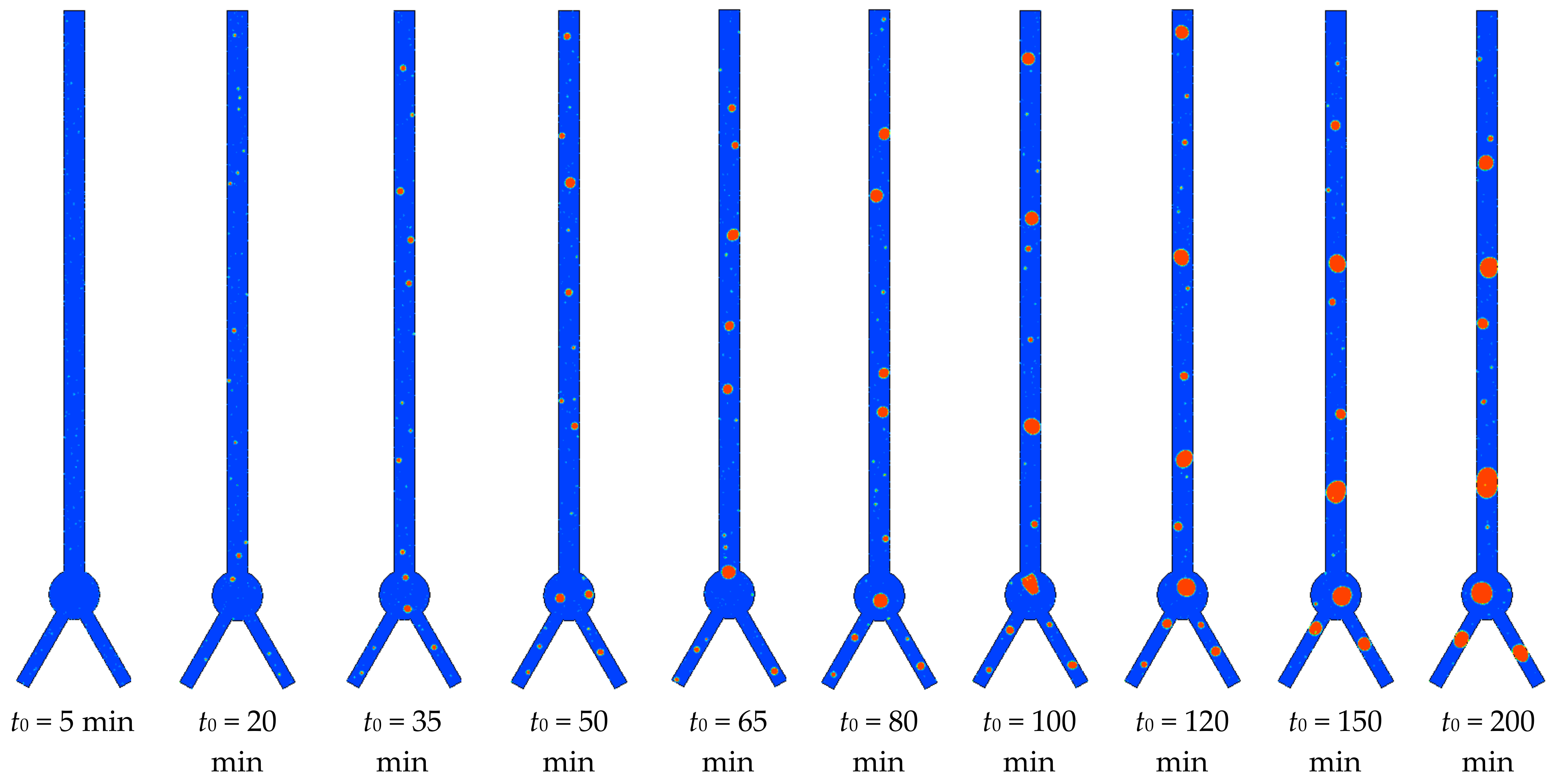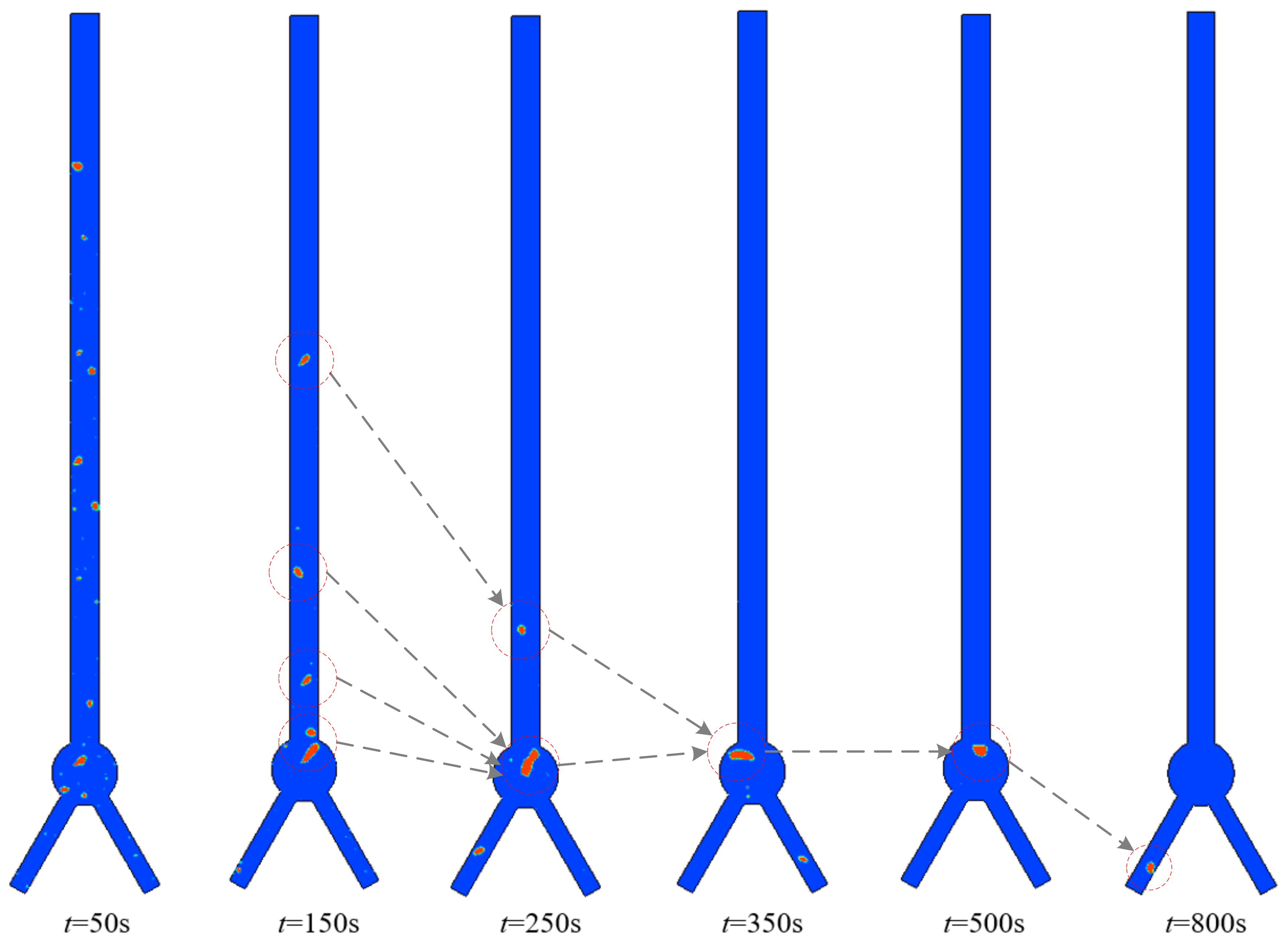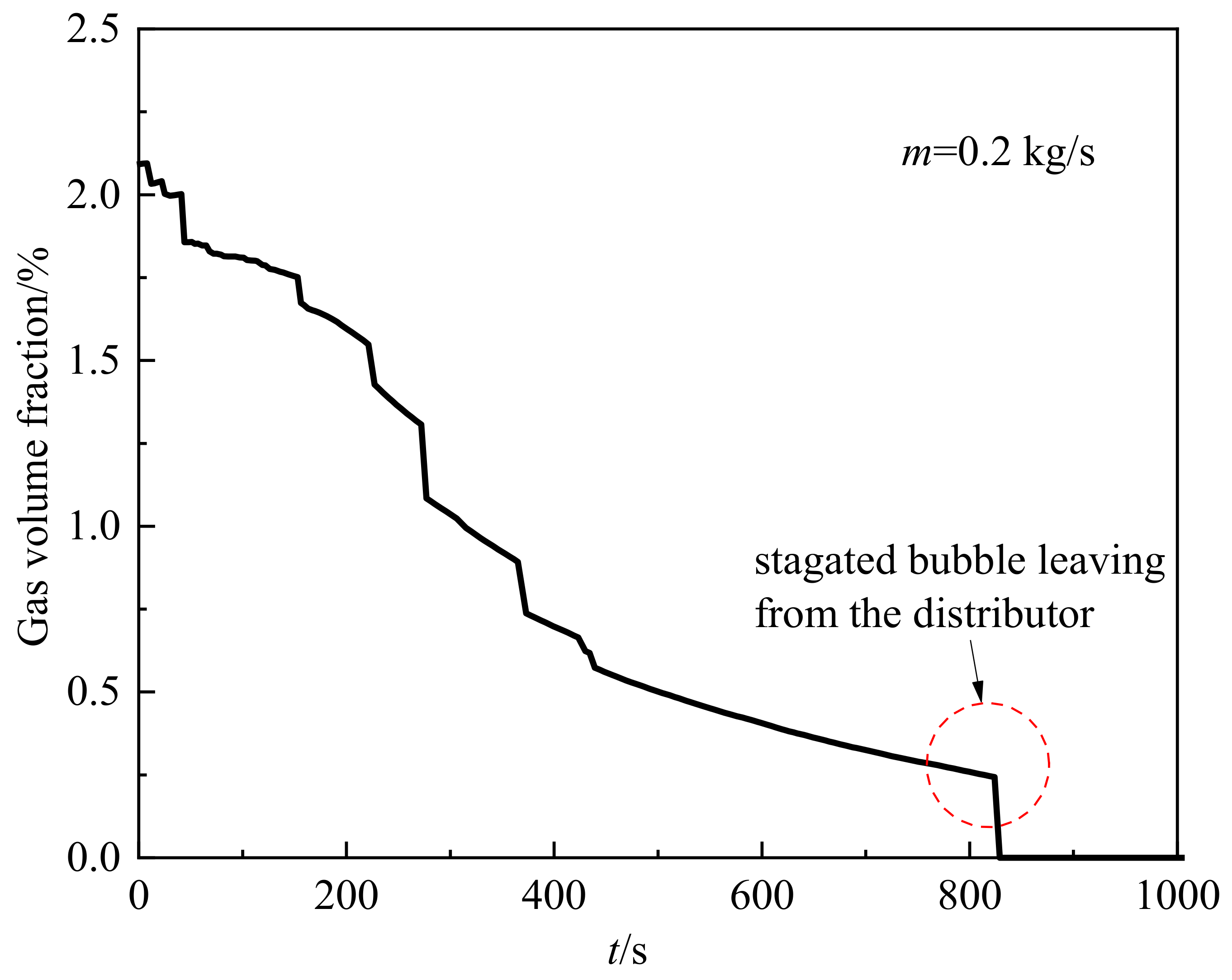CFD Investigation on Movement Features of Hydrogen Bubble under Microgravity Environment
Abstract
:1. Introduction
2. Physical Model
3. CFD Modeling
3.1. Numerical Implementation
3.2. Phase Change Model
3.3. Initial and Boundary Conditions
4. Validation Study
5. Results and Discussion
5.1. Bubble Performance in 0 g0 Condition
5.2. Bubble Spilling Upward under Low-Gravity
5.3. Bubble Motions under Circulation Flow Process
5.4. Influence of Circulation Flow Rates
5.5. Influence of Circulation Flow Subcooling
6. Conclusions
- (1)
- Space heat leakage at the propellant delivery tube may give rise to propellant evaporation, and the generated bubbles increase to a large size through the bubble coalescence effect. The largest bubble even reaches the size of the tube inner diameter. In the thrust design of upper stage, there is an inconsistent requirement in the acceleration level for achieving liquid–gas phase separations in propellant tank and in delivery tube. To meet the bubble discharge purpose inside the tube, a higher acceleration field should be created;
- (2)
- When providing an axial acceleration condition, the generated large bubbles inside the delivery tube may break up under the new force balance and then be discharged under the induced buoyancy effect. For the present tube structure, most of the bubbles are discharged within 200 s under the acceleration level of 10−2 g0. Under 10−3 g0, the bubble discharge time is about 700 s. During the bubble spilling upward, both bubble breakup and bubble coalescence phenomena occur, and only the large bubble discharge exerts a significant effect on the gas volume reduction;
- (3)
- In the circulation flow operation, the gas volume reduction is determined by two different mechanisms, including the vapor condensation effect and bubble discharge effect. In the bubble flow downward process, the bubble entering the spherical distributor and stagnating there has significant influence on the discharge time. For the m = 0.2 kg/s case, a complete bubble discharge target is reached at about 820 s, but a large bubble stagnation in the spherical distributor occupies a remarkable proportion, which is longer than 400 s;
- (4)
- For the liquid circulation flow issue, both of liquid flow rate and liquid subcooling exert important influence on the bubble discharge performance. When applying a large circulation flow, the gas volume reduction mainly owes to the inertial effect of liquid flow, but the bubble stagnation in the spherical distribution affects the total discharge time. The liquid subcooling influence on the gas volume reduction is more significant under small circulation flow situation.
Author Contributions
Funding
Data Availability Statement
Acknowledgments
Conflicts of Interest
Nomenclature
| cp | specific heat, J/(kg·K) |
| d | bubble diameter, m |
| D | tube inner diameter, m |
| F | relaxation parameter for mass transfer, s−1 |
| g | acceleration, m/s2 |
| g0 | normal gravity, g0 = 9.81 m/s2 |
| h | enthalpy, J/kg |
| latent heat, J/kg | |
| m | circulation flow rate, kg/s |
| p | pressure, Pa |
| Prt | Prandtl number |
| S | mass transfer rate, kg/(m3·s) |
| Sh | energy transfer rate, J/(m3·s) |
| t | time, s |
| t0 | zero-g coast time, s |
| T | temperature, K |
| ∆Tsub | liquid subcooling, K |
| Tsat | saturation temperature, K |
| u∞ | bubble spilling velocity, m/s |
| v | fluid velocity, m/s |
| α | volume fraction |
| λ | thermal conductivity, W/(m·K) |
| λeff | effective thermal conductivity, W/(m·K) |
| μ | viscosity, Pa·s |
| ρ | density, kg/m3 |
| σ | surface tension, N/m |
| volumetric weighted average fluid properties | |
| subscripts | |
| l | liquid |
| v | vapor |
| m | mixture |
References
- Heald, D.A.; Holland, K.D. Centaur hydrogen tank venting experience. In Proceedings of the AIAA/NASA Flight Testing Conference, Huntsville, AL, USA, 15–17 February 1965. AIAA 65-216. [Google Scholar]
- Blatt, M.H.; Aydelott, J.C. Centaur propellant acquisition system. J. Spacecr. Rockets 1975, 13, 515–521. [Google Scholar] [CrossRef]
- Groesbeck, W. Centaur upper stage. In Orbital Debris from Upper-Stage Breakup; Loftus, J., Ed.; NASA Johnson Space Center: Houston, TX, USA, 1989; pp. 211–213. [Google Scholar]
- Der, J.J.; Stevens, C.L. Low-gravity bubble reorientation in liquid propellant tanks. In Proceedings of the AIAA 25th Aerospace Sciences Meeting, Reno, NV, USA, 24–26 March 1987. AIAA 87-0622. [Google Scholar]
- Marchetta, J.G.; Roos, K.M. A three-dimensional computational simulation of magnetic positive positioning. In Proceedings of the 45th AIAA Aerospace Sciences Meeting and Exhibit, Reno, NV, USA, 8–11 January 2007. AIAA 2007-956. [Google Scholar]
- Dalmon, A.; Lepilliez, M.; Tanguy, S.; Pedrono, A.; Busset, B.; Bavestrello, H.; Mignot, J. Direct numerical simulation of a bubble motion in a spherical tank under external forces and microgravity conditions. J. Fluid Mech. 2018, 849, 467–497. [Google Scholar] [CrossRef] [Green Version]
- Ma, R.; Lu, X.; Wang, C.; Yang, C.; Yao, W. Numerical simulation of bubble motions in a coaxial annular electric field under microgravity. Aerosp. Sci. Technol. 2020, 96, 105525. [Google Scholar] [CrossRef]
- Dhir, V.K.; Qiu, D.M.; Chao, D.F.; Hasan, M. Bubble dynamics and heat transfer associated with pool nucleate boiling under microgravity conditions. In Proceedings of the Conference and Exhibit on International Space Station Utilization—2001, Cape Canaveral, FL, USA, 15–18 October 2001. AIAA 2001-4995. [Google Scholar]
- Kuhlman, J.; Gray, D.; Glaspell, S.; Kreitzer, P. Positioning of bubbles in microgravity by the Kelvin force. In Proceedings of the 38th AIAA Thermalphysics Conference, Toronto, ON, Canada, 6–9 June 2005. AIAA 2005-5201. [Google Scholar]
- Davisson, J.C.; Mcharris, G.A. S-IVB restart chilldown experience. J. Spacecr. 1971, 8, 99–104. [Google Scholar] [CrossRef]
- Herman, C.; Iacona, E.; Földes, I.; Suner, G.; Milburn, C. Experimental visualization of bubble formation from an orifice in microgravity in the presence of electric fields. Exp. Fluids 2002, 32, 396–412. [Google Scholar] [CrossRef]
- Burke, P.A.; Dunbar, B.J. Development of computational fluid dynamic (CFD) models of the formation and buoyancy-driven detachment of bubbles in variable gravity environments. In Proceedings of the AIAA SciTech Forum, Virtual Event, 11–15 & 19–21 January 2021. AIAA 2021-1838. [Google Scholar]
- Colin, C.; Riou, X.; Fabre, J. Bubble coalescence in gas-liquid flow at microgravity conditions. Microgravity Sci. Technol. 2008, 20, 243–246. [Google Scholar] [CrossRef]
- Zhao, J.-F.; Li, J.; Yan, N.; Wang, S.-F. Bubble behavior and heat transfer in quasi-steady pool boiling in microgravity. Microgravity Sci. Technol. 2009, 21, 175–183. [Google Scholar] [CrossRef] [Green Version]
- Wang, T.; Li, H.; Zhao, J. Three-dimensional numerical simulation of bubble dynamics in microgravity under the influence of nonuniform electric fields. Microgravity Sci. Technol. 2016, 28, 133–142. [Google Scholar] [CrossRef] [Green Version]
- Luo, X.-Y.; Ni, M.-J.; Ying, A.; Abdou, M. Numerical analysis of phase change and dynamics associated with bubbles and droplets. In Proceedings of the 17th AIAA Computational Fluid Dynamics Conference, Toronto, ON, Canada, 6–9 June 2005. AIAA 2005-5346. [Google Scholar]
- De Bernardis, E.; Riccardi, G. Dynamics of a bubble rising in gravitational field. Commun. Appl. Ind. Math. 2016, 7, 48–67. [Google Scholar] [CrossRef] [Green Version]
- Cao, B.; Fan, J.; Sun, X.; Li, S. Numerical simulation of mass-transfer characteristics of a bubble rising in yield stress fluids. ACS Omega 2020, 5, 13878–13885. [Google Scholar] [CrossRef]
- Van Sint Annaland, M.; Deen, N.G.; Kuipers, J.A.M. Numerical simulation of gas bubbles behaviors using a three dimensional volume of fluid method. Chem. Eng. Sci. 2005, 60, 2999–3011. [Google Scholar] [CrossRef]
- Vishnu, S.B.; Kuzhiveli, B.T. Effect of micro- and elevated gravity condition on the evolution of stratification and self-pressurization in a cryogenic propellant tank. Indian Acad. Sci. 2019, 44, 63. [Google Scholar] [CrossRef] [Green Version]
- Zeng, C.; Yuan, B.; Meng, Z.; Zhang, X.; Jiang, H.; Mu, D.; Yan, R. Numerical investigation of helium bubble rising behavior in cross-type channel. Front. Energy Res. 2020, 8, 184. [Google Scholar] [CrossRef]
- Agarwal, R.; Dondapati, R.S. Numerical investigation on hydrodynamic characteristics of two-phase flow with liquid hydrogen through cryogenic feed lines at terrestrial and microgravity. Appl. Therm. Eng. 2020, 173, 115240. [Google Scholar] [CrossRef]
- Pesich, J.M.; Hauser, D.M.; Hartwig, J.W.; Kassemi, M.; Kinefuchi, K.; Umemura, Y.; Himeno, T. CFD modeling of cryogenic chilldown in a complex channel under normal and low gravity conditions. In Proceedings of the AIAA Propulsion and Energy 2020 Forum, Virtual Event, 24–28 August 2020. AIAA 2020-3818. [Google Scholar]
- Wang, J.; Li, Y.; Wang, L.; Xia, S.; Ren, J.; Mao, H.; Xu, Y. Numerical investigation on subcooled pool film boiling of liquid hydrogen in different gravities. Int. J. Hydrog. Energy 2021, 46, 2646–2657. [Google Scholar] [CrossRef]
- Wang, J.; Li, Y.; Wang, L. Numerical study on pool film boiling of liquid hydrogen over horizontal cylinders. Energies 2022, 15, 1044. [Google Scholar] [CrossRef]
- Malekzadeh, S.; Roohi, E. Investigation of different droplet formation regimes in a T-junction microchannel using VOF technique in OpenFOAM. Microgravity Sci. Technol. 2015, 27, 231–243. [Google Scholar] [CrossRef]
- Pu, L.; Li, H.; Lv, X.; Zhao, J.; Chen, T.; Zhu, Y. Numerical simulation of bubble dynamics in microgravity. Microgravity Sci. Technol. 2008, 20, 247–251. [Google Scholar] [CrossRef]
- Pu, L.; Li, H.; Zhao, J.; Chen, T. Numerical simulation of condensation of bubbles under microgravity conditions by moving mesh method in the double-staggered grid. Microgravity Sci. Technol. 2009, 21, S15–S22. [Google Scholar] [CrossRef] [Green Version]
- Cano-Lozano, J.C.; Jimenez, R.B.; Gutierrez-Montes, C.; Martínez-Bazán, C. The use of volume of fluid technique to analyze multiphase flows: Specific case of bubble rising in still liquids. Appl. Math. Model. 2015, 39, 3290–3305. [Google Scholar] [CrossRef]
- Daryaei, A.; Hanafizadeh, P.; Akhavan-Behabadi, M.A. Three-dimensional numerical investigation of a single bubble behavior against non-linear forced vibration in a microgravity environment. Int. J. Multiph. Flow 2018, 109, 84–97. [Google Scholar] [CrossRef]
- Martian, J.; Holt, J. Magnetically actuated propellant orientation, controlling fluids in a low-gravity environment. In Proceedings of the 36th AIAA/ASME/SAE/ASEE Joint Propulsion Conference and Exhibit, Huntsville, AL, USA, 24–28 July 2000. AIAA 2000-3440. [Google Scholar]
- Zhang, R.-P.; Bao, S.-R.; Gu, C.-J.; Qiu, L.-M.; Zhi, X.-Q.; Zhang, X.-B. Numerical study on the bubble rising behavior in liquid oxygen under magnetic field. Cryogenics 2019, 101, 43–52. [Google Scholar] [CrossRef]
- Yang, Q.; Li, B.Q.; Shao, J.; Ding, Y. A phase field numerical study of 3D bubble rising in viscous fluids under an electric field. Int. J. Heat Mass Transf. 2014, 78, 820–829. [Google Scholar] [CrossRef]
- Shi, J.; Ma, Q.; Chen, Z. Numerical study on bubble motion in pore structure under microgravity using the lattice Boltzmann method. Microgravity Sci. Technol. 2019, 31, 207–222. [Google Scholar] [CrossRef]
- Amaya-Bower, L.; Lee, T. Numerical simulation of single bubble rising in vertical and inclined square channel using lattice Boltzmann method. Chem. Eng. Sci. 2011, 66, 935–952. [Google Scholar] [CrossRef]
- Zhang, A.; Sun, P.; Ming, F. An SPH modeling of bubble rising and coalescing in three dimensions. Comput. Methods Appl. Mech. Eng. 2015, 294, 189–209. [Google Scholar] [CrossRef]
- Liu, X.; Chen, Y.; Shi, M. Influence of gravity on gas-liquid two-phase flow in horizontal pipes. Int. J. Multiph. Flow 2012, 41, 23–35. [Google Scholar] [CrossRef]
- Darzi, M.; Park, C. Hydrodynamics of intermediate-scale Taylor flow under gravities of space colonies. Microgravity Sci. Technol. 2019, 31, 865–876. [Google Scholar] [CrossRef]
- Xu, Y.; Zhu, Z.; Xiong, X. Numerical study of flow boiling flow patterns and pressure drop of R134a in small tubes under high flight acceleration. J. Braz. Soc. Mech. Sci. Eng. 2020, 42, 482. [Google Scholar] [CrossRef]
- Mao, H.; Li, Y.; Wang, L.; Wang, J.; Xie, F. Investigation of appearance and intensity of geyser phenomenon in a vertical cryogenic pipe. Int. J. Heat Mass Transf. 2020, 150, 119390. [Google Scholar] [CrossRef]
- Mao, H.; Li, Y.; Wang, L.; Xie, F.; Wang, J. Investigation on the difference of geyser behaviors among different cryogenic fuels of launch vehicle. Int. J. Hydrog. Energy 2020, 45, 34150–34162. [Google Scholar] [CrossRef]
- Mao, H.; Li, Y.; Wang, L.; Wang, J.; Xie, F. Numerical investigation on the mechanism of geyser in cryogenic fluid pipes. Int. J. Heat Mass Transf. 2020, 154, 119670. [Google Scholar] [CrossRef]
- Fisher, M.F. Propellant management in booster and upper-stage propulsion systems. J. Propuls. Power 1998, 14, 649–656. [Google Scholar] [CrossRef] [Green Version]
- Wang, L.; Wang, J.; Shangguan, S.; Qu, M.; Mao, H.; Li, Y.; Lei, G. Numerical investigation on spilling upward performance of hydrogen bubbles inside a delivery tube under low-gravity environment. Cryogenics 2021, 118, 103333. [Google Scholar] [CrossRef]
- Kharangate, C.R.; Mudawar, I. Review of computational studies on boiling and condensation. Int. J. Heat Mass Transf. 2017, 108, 1164–1196. [Google Scholar] [CrossRef]
- Da Riva, E.; Del Col, D. Numerical simulation of laminar liquid film condensation in a horizontal circular minichannel. J. Heat Transf. 2012, 134, 051019. [Google Scholar] [CrossRef]
- Bellur, K.; Konduru, V.; Kulshreshtha, M.; Tyrewala, D.; Medici, E.; Allen, J.S.; Choi, C.K.; Hussey, D.S.; Jacobson, D.C.; Leão, J.B.; et al. Contact angle measurement of liquid hydrogen (LH2) in stainless steel and aluminum cells. J. Heat Transf. 2016, 138, 020904. [Google Scholar] [CrossRef]
- Moissis, R.; Griffith, P. Entrance effects in a two-phase slug flow. J. Heat Transf. Trans. ASME 1962, 84, 29–39. [Google Scholar] [CrossRef]
- Zhang, L. Study on Geyser Phenomenon and Natural Circulation Analysis of Cryogenic Fluid in Vertical Pipeline; Shanghai Jiaotong University: Shanghai, China, 2004. (In Chinese) [Google Scholar]
- Muratov, C.B.; Osipov, V.V.; Smelyanskiy, V.N. Issues of Long-Term Cryogenic Propellant Storage in Microgravity; NASA/TM 2011-215988; NASA Ames Research Center: Moffett Field, CA, USA, 2011. [Google Scholar]











| Parameters | Values | |
|---|---|---|
| Main tube | Inner diameter | 155 mm |
| Wall thickness | 4 mm | |
| Pipeline length | 4 m | |
| Heat leakage | 1 W/m2 | |
| Branch tube | Inner diameter | 100 mm |
| Wall thickness | 3.5 mm | |
| Pipeline length | 0.56 m | |
| Heat leakage | 1 W/m2 | |
| Spherical distributor | Inner diameter | 300 mm |
| Parameters | Values | |
|---|---|---|
| Initial liquid pressure | 0.4 MPa | |
| Initial liquid temperature | 25.95 K | |
| Contacting angle | 5° | |
| Gravity level | Coast stage | 0 g0 |
| Propellant reorientation | 10−1 g0–10−4 g0 | |
| Circulation flow | 10−3 g0 | |
| Flow rate in circulation flow | 0.1 kg/s, 0.2 kg/s, 0.4 kg/s | |
| Liquid subcooling in circulation quenching | 0 K, 1 K, 2 K | |
Publisher’s Note: MDPI stays neutral with regard to jurisdictional claims in published maps and institutional affiliations. |
© 2022 by the authors. Licensee MDPI, Basel, Switzerland. This article is an open access article distributed under the terms and conditions of the Creative Commons Attribution (CC BY) license (https://creativecommons.org/licenses/by/4.0/).
Share and Cite
Wang, L.; Sun, P.; Yan, L.; Shangguan, S.; Qu, M.; Li, Y. CFD Investigation on Movement Features of Hydrogen Bubble under Microgravity Environment. Energies 2022, 15, 7528. https://doi.org/10.3390/en15207528
Wang L, Sun P, Yan L, Shangguan S, Qu M, Li Y. CFD Investigation on Movement Features of Hydrogen Bubble under Microgravity Environment. Energies. 2022; 15(20):7528. https://doi.org/10.3390/en15207528
Chicago/Turabian StyleWang, Lei, Peijie Sun, Li Yan, Shi Shangguan, Miao Qu, and Yanzhong Li. 2022. "CFD Investigation on Movement Features of Hydrogen Bubble under Microgravity Environment" Energies 15, no. 20: 7528. https://doi.org/10.3390/en15207528





